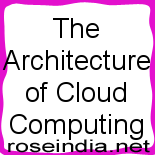Just a few years back cloud computing used to be considered as the most feasible alternative in the horizon to replace gigantic IT infrastructure in large corporations and hardware specific information sharing experience and now it is no more in the horizon looming large with possibilities but just a obvious reality that is pushing the boundaries of our computing experience through a wide array of devices. Architecture of cloud computing incorporates many aspects that remained major points of concern in traditional IT infrastructure. Obviously there are aspects of weaklings as well like lack of security measure, lack of control, less reliability in delivering crucial business process, etc. But as cloud computing is relatively new and needs to be nurtured in various IT and business environments, these cannot be straightforwardly taken as negative. Moreover, the question of open and non device specific accessibility and synchronization of data over a network and range of devices is nevertheless revolutionary.
Typically architecture of cloud computing consists of 5 interconnected stages or functional areas, namely cloud platform, cloud storage, cloud services, cloud applications and finally cloud clients. While cloud platform is the web server or application server that works in a cloud environment, cloud storage denotes the virtual storage capacity that is rendered as a service to the end user rather than a hardware device for storage. Cloud service is typically the area that addresses the necessity of service oriented architecture as per the web service standard and cloud applications are software or programming that are made accessible to end user as a service. Cloud client is the final determinant of all the different aspects of cloud infrastructure we described and all the mobile and computing devices or browsers through which cloud applications and information can be accessed are denoted as cloud client. Let us now have a closer look at these different functional areas in the architecture of cloud computing.
Cloud Platform:
By cloud platform we basically denote the infrastructure required for developing and operating the web based software applications. From application design to development, testing, deployment, hosting all comes under this category. Besides that team collaboration, security measures, process of versioning and instrumentation are also integral part of cloud platform. The virtual servers that are intrinsic part of cloud environment may include web server, database engines and application server and developer team with their collaborative work process assures the leverage of the virtual cloud server and cloud platform for the application to perform.
Cloud Storage:
Called erstwhile as utility computing or virtual storage, cloud storage is the definitive part in the architecture of cloud computing. As opposed to saving user's data in his computer hard disk or device storage, through cloud storage you save data over the virtual internet storage spread over multiple applications on the internet. Through the leverage of cloud storage you can now store your data from any device anywhere and retrieve the same as and when required from any device.
Cloud Service:
Cloud service is typically the area that addresses the synchronization and integration of web browser with different cloud interfaces to render the accessibility of cloud environment and its practical use across different device interfaces. How various systems will be integrated into a network or how system integration can be done seamlessly to provide the interface for cloud computing is addressed by cloud service.
Cloud Application:
Cloud applications like its predecessor as desktop applications can be accessed through any device once you subscribe to the service or downloaded it from internet. These applications can be accessed online as well using an internet connection. But what make the use and benefits of these applications in a cloud environment different is the better synching capacity of the application among multiple devices and sharing a process that started in a different device through accessing it from another. Suppose, you were editing a photo on your computer using such a cloud application and you had to quit the task unfinished, but on your way through your mobile device you can access the same unfinished work and continue working on it if the application in both the devices are synched through internet.
Cloud Clients:
Cloud Clients are nothing but the multiple devices and web browsers which let you access the cloud applications. These devices can be any computing device like a multimedia phone or so called Smartphone, a tablet, laptop, a desktop computer or it may also refer to various web browsers like Google Chrome, Mozilla Firefox, etc. which are client interfaces to let the user access various cloud applications. These devices and browser interfaces which are referred as cloud clients are the ultimate frontier of the architecture of cloud computing.
